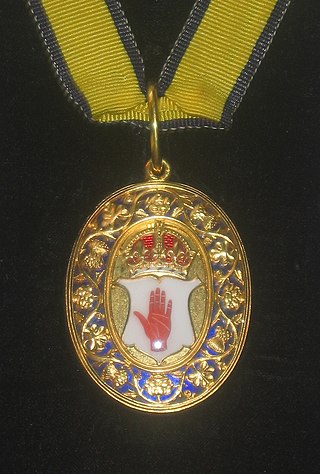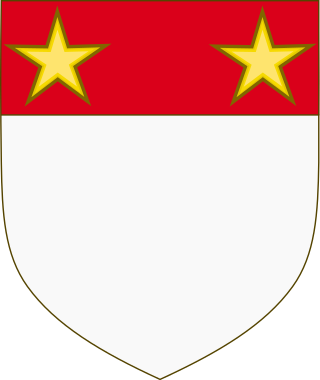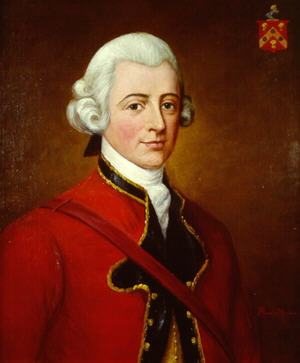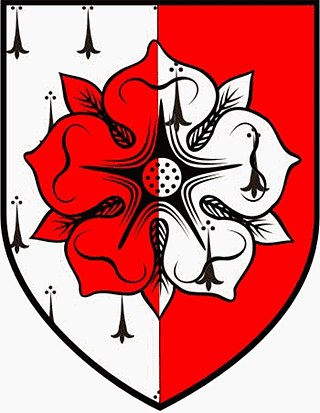
A baronet or the female equivalent, a baronetess, is the holder of a baronetcy, a hereditary title awarded by the British Crown. The title of baronet is mentioned as early as the 14th century; however, in its current usage it was created by James I of England in 1611 as a means of raising funds for the crown.

Baron St John of Bletso, in the County of Bedford, is a title in the Peerage of England. It was created in 1582 for Oliver St John.

Viscount Hill, of Hawkstone and of Hardwicke in the County of Salop, is a title in the Peerage of the United Kingdom. It was created in 1842 for General Rowland Hill. He had already been created Baron Hill, of Almaraz and of Hawkstone in the County of Salop, in 1814, with remainder to the heirs male of his body, and Baron Hill, of Almarez and of Hawkestone and Hardwicke in the County of Salop, in 1816, with remainder to the heirs male of his elder brother John Hill. The viscountcy was created with the same special remainder. On the first Viscount's death in 1842, the barony of 1814 became extinct as he had no male issue, while he was succeeded in the barony of 1816 and the viscountcy according to the special remainders by his nephew Sir Rowland Hill, 4th Baronet. His son, the 3rd Viscount, sat as a Conservative Member of Parliament for Shropshire North. In 1875, he assumed by royal licence the additional surname of Clegg, which was that of his maternal grandfather. He inherited financial problems from his father which led to the breakup and sale of the family estates.

Baron Stanley of Alderley, in the County of Chester, is a title in the Peerage of the United Kingdom. It was created in 1839 for the politician and landowner Sir John Stanley, 7th Baronet.

There have been seven baronetcies created for members of the Lowther family, one in the Baronetage of Nova Scotia, two in the Baronetage of England, two in the Baronetage of Great Britain and two in the Baronetage of the United Kingdom. Two of the creations are extant as of 2008.

The Eden Baronetcy, of West Auckland in the County of Durham, and the Eden Baronetcy, of Maryland in North America, are two titles in the Baronetage of England and Baronetage of Great Britain respectively that have been united under a single holder since 1844.
The Egerton, laterGrey Egerton, later stillEgerton baronetcy, of Egerton and Oulton in the county of Chester, is a title in the Baronetage of England held by the senior patrilineal branch of the Egerton family.
There have been two baronetcies created for members of the Blackett family, both in the Baronetage of England. One creation is extant as of 2013. The Blackett family can be traced back to the Blacketts/Blakheveds of Woodcroft, County Durham, some of whom became highly successful in the lead and coal mining industries in Northumberland and County Durham.
There have been three baronetcies created for persons with the surname Baillie, one in the Baronetage of Nova Scotia and two in the Baronetage of the United Kingdom. As of 2014 one creation is extant.
There have been four baronetcies created for persons with the surname Stanley, all in the Baronetage of England. Two of the creations are extant as of 2010.
There have been six baronetcies created for persons with the surname Brooke, one in the Baronetage of England, one in the Baronetage of Ireland and four in the Baronetage of the United Kingdom. As of 2015 four of the creations are extant, though one has been subsumed into a peerage.

The de Capell-Brooke Baronetcy, of Oakley in the County of Northampton, was a title in the Baronetage of the United Kingdom. It was created on 20 June 1803 for Richard de Capell-Brooke, a bencher of the Inner Temple and for 30 years a Colonel of the Northamptonshire Militia. Born Richard Supple, he was the son of Richard Supple, of Ahadoe, who in the 1750s married Mary, daughter of Arthur Brooke, of Great Oakley, Northamptonshire. In 1797 he inherited the Great Oakley estate from his great-uncle, Wheeler Brooke, and assumed at that time by sign manual and in obedience to the testamentary injunction of his great-uncle the surname Brooke as well as the original surname of his family, de Capell. He was succeeded by his eldest son, the second Baronet, who was a noted travel writer and Fellow of the Royal Society. The fifth Baronet was High Sheriff of Rutland in 1899, a deputy lieutenant of Northamptonshire and a justice of the peace and also unsuccessfully stood three times for the parliamentary seat of East Northamptonshire. On 4 July 1939 he was elevated to the Peerage of the United Kingdom as Baron Brooke of Oakley, of Oakley in the County of Northampton. The barony became extinct on his death in 1944 while he was succeeded in the baronetcy by Sir Edward de Capell-Brooke, the fifth Baronet. The baronetcy became extinct on the latter's death in 1968.

Ness is a village on the Wirral Peninsula, in the part that remains in the ceremonial county of Cheshire, England. It is situated near to the town of Neston, in the unitary authority of Cheshire West and Chester. It constitutes part of the Burton & Ness Ward of the district, with the ward having a total population of 1,620 in the 2001 Census.

There have been two baronetcies created for persons with the surname Bowman, both in the Baronetage of the United Kingdom.
There have been two baronetcies created for members of the Morrison-Bell family, both in the Baronetage of the United Kingdom.

The Payne, later Payne-Gallwey, and from 1967 Frankland-Payne-Gallwey Baronetcy, was a title in the Baronetage of the United Kingdom. It was created on 8 December 1812 for General William Payne, Governor of the Leeward Islands. Payne-Gallwey was the half-brother of Ralph Payne, 1st Baron Lavington, who also served as Governor of the Leeward Islands.
There have been two baronetcies created for members of the Haggerston, later Constable Maxwell-Scott family, one in the Baronetage of England and one in the Baronetage of the United Kingdom. Only one creation is extant as of 2008. The Haggerston, later Constable Maxwell-Scott Baronetcy, of Haggerston in the County of Northumberland, was created in the Baronetage of England on 15 August 1642 for Thomas Haggerston, of Haggerton Castle, Northumberland, a loyal Royalist who served as a colonel in the army of King Charles I. The Haggerston were recusant in the 17th century and the estates were sequestered and forfeit to the Commonwealth of England in 1649 but were repurchased by the first Baronet in 1653. The line of the fourth Baronet failed on the death of the twelfth Baronet in 1972. The title reverted to the line of William Haggerston, second son of the third Baronet and younger brother of the fourth Baronet. In 1746 he inherited estates in Yorkshire from his great-uncle Sir Marmaduke Francis Constable, 4th and last Baronet, of Everingham, and assumed the surname of Constable in lieu of his patronymic. In 1758 he married Winifred, daughter of Robert Maxwell, titular sixth Earl of Nithsdale, and assumed by Royal licence the additional surname of Maxwell. Winifred was considered to be the heiress to the Scottish lordship of Herries of Terregles held by her father. Constable-Maxwell built a new house at Everingham Park on the Constable estate in Yorkshire.

The Nightingale Baronetcy of Newport Pond is a title in the Baronetage of England and a rank in the British aristocracy. It was created by King Charles I of England, on 1 September (1628), and is one of the oldest baronetcies to remain active in England.

The Osborne, later Osborn Baronetcy, of Chicksands in the County of Bedford, is a title in the Baronetage of England. It was created on 11 February 1662 for John Osborne, subsequently Remembrancer to the Treasury from 1674 to 1698. The baronetcy was in recognition of the sufferings the family had suffered for its support of Charles I.

Sir Richard Bulkeley Williams-Bulkeley, 10th Baronet was an English Whig and Liberal Party politician who sat in the House of Commons variously between 1831 and 1868.


















